Selecting the right fish tank is a crucial step in creating a healthy and vibrant aquarium. Your choice affects not just the well-being of your fish but also the ease of maintaining their environment. As you embark on this exciting journey, remember to consider the space requirements for your fish to move and grow. A tank that’s too small can hinder their development and increase stress, leading to health issues.
When balancing your budget with your aquarium dreams, going for a larger tank might initially seem like a stretch, but it’s an investment in the long-term happiness of your fish. Moreover, a spacious environment for your aquatic pets often means a more stable ecosystem that’s easier to manage. Tanks above 10 gallons, for example, will not only give your fish ample room but also offer more forgiveness with water quality fluctuations, making your maintenance routine more manageable.
As you ponder on size, also keep in mind the weight of a fully equipped aquarium. A ten-gallon setup can weigh around 100 pounds, while a 55-gallon can tip the scales at about 600 pounds once filled with water, substrate, and decorations. Therefore, ensure that you have a robust stand designed for the tank size you select to guarantee a safe and secure display of your underwater sanctuary.
Determining Your Needs
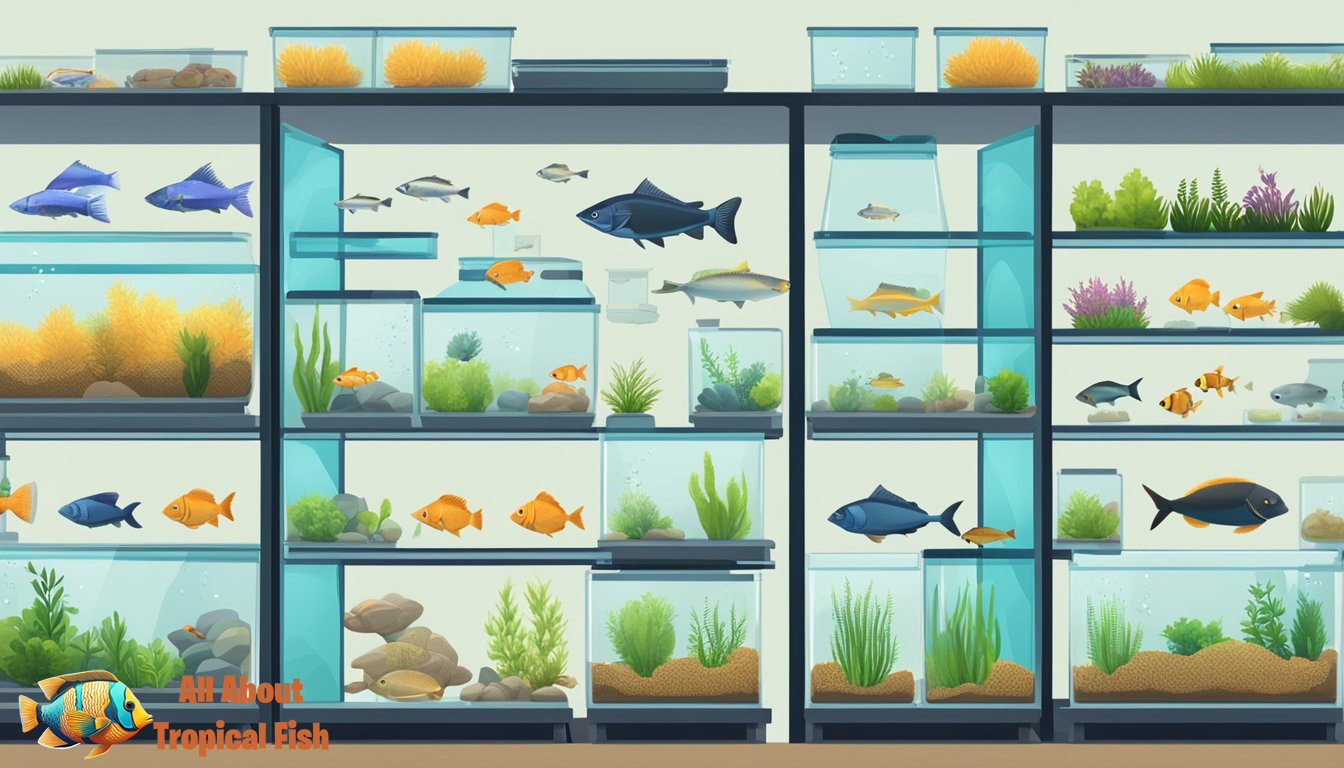
When embarking on the exciting journey of setting up a new aquarium, there are a few key aspects that will guide your decision-making process. These include the space you have available, the specific needs of the species you wish to keep, and the maintenance requirements that will fit with your lifestyle and budget.
Assessing Space Availability
Before you make any decisions, take a look at where you plan to place your aquarium. Measure the length, width, and height of this area to determine the maximum size of the tank that will fit comfortably. Remember that you’ll need extra room around the tank for equipment and maintenance access. Here’s a quick reference to evaluate the space you have:
- Location: Choose a stable and level surface away from direct sunlight and high-traffic areas.
- Dimensions: Note the maximum allowable dimensions for length x width x height.
Understanding Fish Species Needs
The type and species of fish you’re interested in will greatly affect the size of the tank you’ll need. As a rule of thumb, you’ll need roughly one gallon of water for each inch of fish, though this is a bare minimum; more space is always better. Here’s a simple way to break it down:
- Small fish (<3 inches): At least 10 gallons to provide swimming room and adequate territory.
- Larger fish (>3 inches): Consider tanks 20 gallons or more based on the species’ full adult size and activity level.
Evaluating Maintenance Requirements
Larger tanks can be more stable and easier to maintain in the long run, but they require a more significant initial effort and budget for setup and ongoing care. Take into account the following:
- Filtration: Choose a filter system that can handle 3-5 times your tank’s volume per hour.
- Budget: Larger tanks and high-quality equipment will require a higher initial investment but can provide a better environment for your fish.
Making well-informed decisions at this stage will help ensure a positive and rewarding aquarium experience.
Exploring Tank Sizes and Types
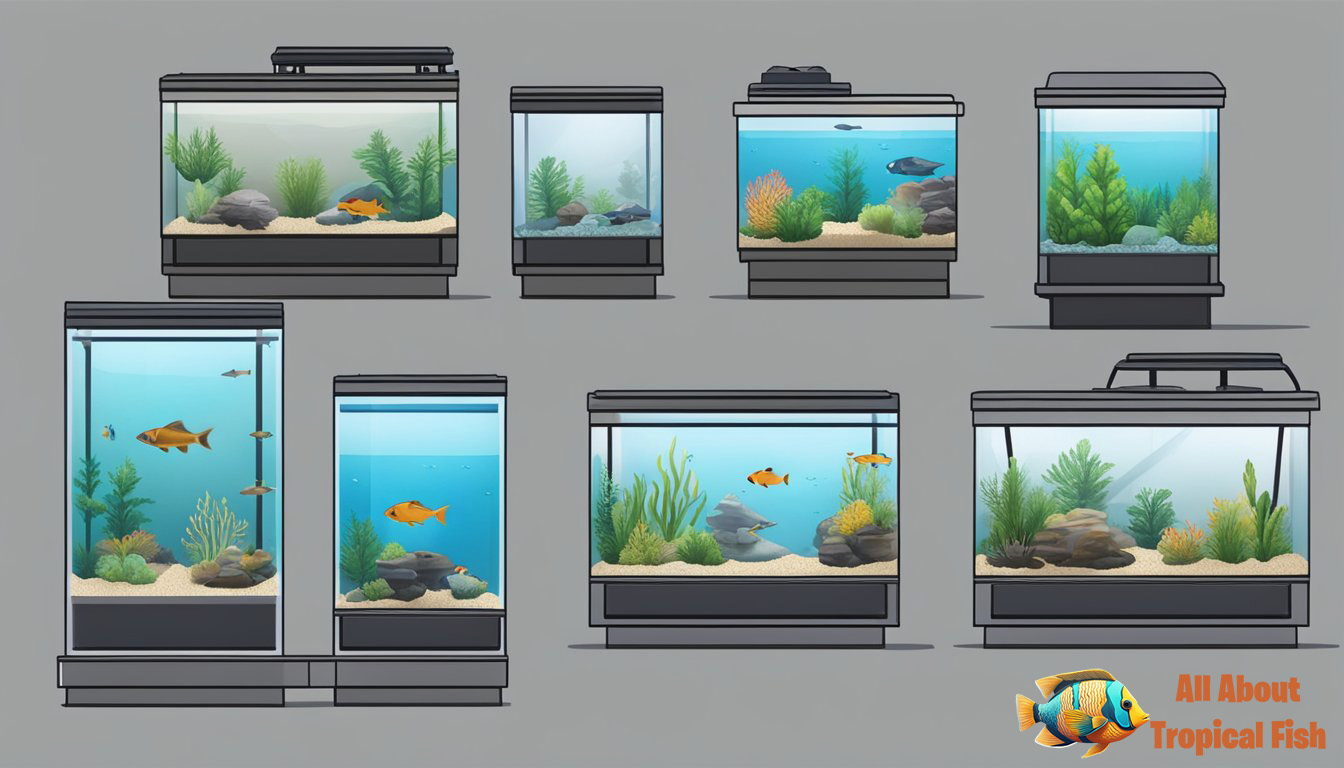
Let’s navigate the options available, from standard sizes to materials and designs.
Comparing Standard Tank Sizes
Small Tanks (5-20 gallons): Ideal for beginners or limited spaces, these tanks are suitable for small fish species. For example, a 10-gallon tank gives you the flexibility to keep a mix of small fish and invertebrates.
Medium Tanks (20-40 gallons): Offering more room for your aquatic life, these tanks can host a greater variety of fish and provide space for more elaborate decorations or plant life.
Large Tanks (40-100+ gallons): These can support an extensive ecosystem, including larger fish species and intricate aquascaping. For instance, a 75-gallon tank measures approximately 48 x 18 x 21 inches, offering substantial space for fish to thrive.
Distinguishing Between Tank Materials
- Glass: Highly durable and scratch-resistant, glass tanks offer a clear view but are typically heavier.
- Acrylic: These tanks are lighter and more impact-resistant than glass, but can scratch more easily.
- Plastic: Often used in smaller tanks or bowls, plastic is lightweight but may not offer the same clarity or longevity as glass or acrylic.
Examining Tank Shapes and Styles
- Rectangular Tank: The most common shape, providing a stable environment and maximizing oxygenation due to a larger surface area.
- Bowls and Jars: Generally smaller and suitable for limited spaces or a few small fish, though they may not be ideal for fish health due to limited surface area for gas exchange.
Remember that your choice dramatically influences the well-being of your fish and the overall maintenance of the aquarium.
Essential Equipment and Accessories
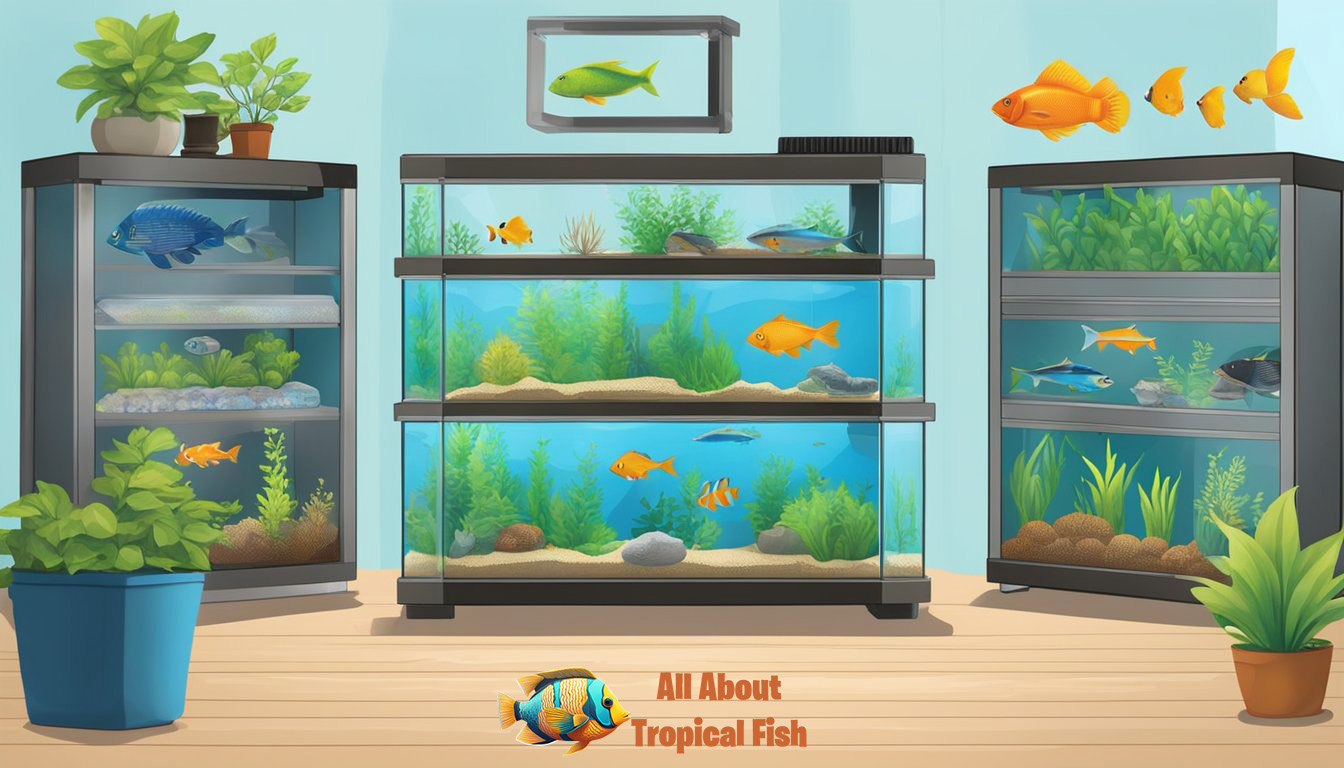
When setting up your new fish tank, selecting the right equipment and accessories is crucial for creating a healthy and vibrant aquatic environment. From filtration systems to lighting, each component plays a pivotal role.
Selecting a Suitable Filtration System
Your filtration system is the heart of your fish tank, keeping the water clean and safe for your aquatic friends. Choose a filter that matches the size of your tank and the type of fish you’ll keep. The filter should effectively remove physical waste, chemical impurities, and contribute to biological filtration by converting harmful ammonia into safer substances.
Choosing Heaters and Thermometers
Maintaining the correct water temperature is essential for your fish’s well-being. A reliable heater will ensure a consistent and suitable water temperature, tailored to your fish species’ specific needs. Along with a heater, include a thermometer to monitor your aquarium’s temperature, ensuring it stays within the desired range.
Investing in Lighting and Decorations
Lighting not only showcases your aquascape, but also regulates the life cycle of any live plants you have. Depending on the needs of your plants and fish, invest in appropriate lighting that encourages plant growth and enhances the natural colors of your fish. Adding decorations and substrate provides hiding spaces for fish and contributes to the overall aesthetic of your tank. Choose safe, non-toxic materials and consider the natural habitat of your fish while designing your aquascape.
Setting Up Your Aquarium
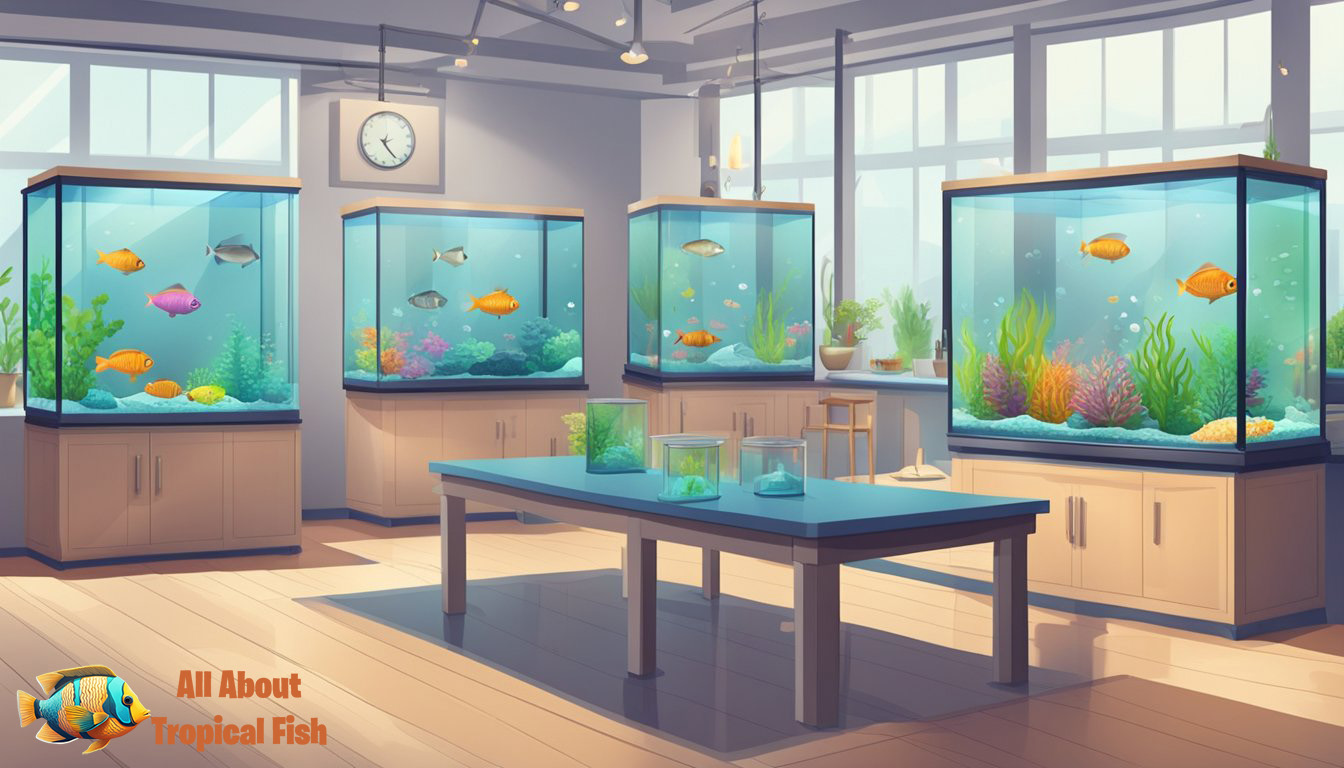
This involves a process with specific steps, an understanding of the biological ecosystem, and attention to maintaining water quality.
Following a Step-by-Step Guide
- Choose Your Aquarium: Select a size that fits your space and is large enough to accommodate your fish as they grow.
- Install Equipment: Set up the essential gear like filters for cleanliness and heaters for temperature control. A thermometer to keep an eye on water temperature.
- Arrange Your Substrate: Lay the foundation with an appropriate substrate; it could be gravel or specialized plant soil if you’re planning a planted tank.
- Decorate: Add decorations and hiding spaces to mimic natural habitats and provide comfort.
- Fill With Water: Slowly add room temperature water, treating it with a water conditioner to remove chlorine and other chemicals.
Understanding the Nitrogen Cycle
- Cycle Your Tank: Before adding your fish, it’s imperative to cycle the tank, typically taking 4-6 weeks. This allows beneficial bacteria to establish in your filter and substrate that will convert harmful ammonia to nitrite, and finally to less harmful nitrate.
- Testing is Crucial: Invest in a reliable water testing kit to monitor ammonia, nitrite, and nitrate levels throughout the cycling process.
Ensuring Proper Water Quality
- Regular Monitoring: Once your fish are in the aquarium, you’ll want to test water parameters like pH, nitrate, and oxygen levels at least weekly.
- Water Changes: Perform routine water changes, removing and replacing about 25% of the tank water to keep nitrate levels safe.
- Water Treatments: Use water treatments as needed, like conditioners to neutralize harmful chemicals or adjusters to stabilize pH levels.
Implementing these practices will lead to a thriving aquarium where your fish can live healthily and happily.
Fish Tank Care and Maintenance
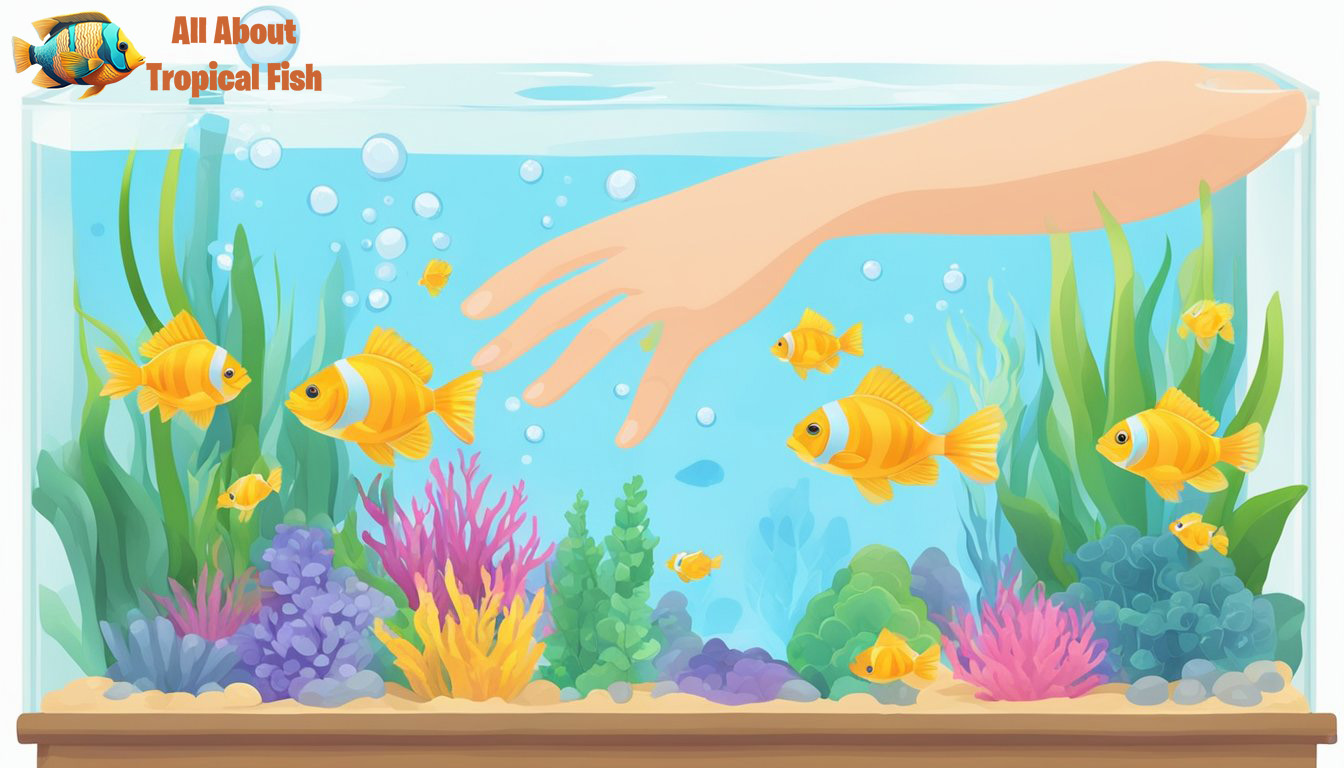
Effectively maintaining your fish tank ensures the health and happiness of your fish. Paying careful attention to daily and weekly tasks, filtration, and temperature management, as well as waste control, will create a thriving environment for your fish.
Mastering Daily and Weekly Tasks
Daily Checks:
Every day, you should monitor the water temperature to keep it within the optimal range for your specific fish species. It’s also important to observe the behavior and appearance of your fish, as these can be early indicators of potential problems.
- Temperature: Maintain a consistent temperature suitable for your fish species.
- Observation: Keep an eye on fish activity and look out for signs of stress or illness.
Weekly Maintenance:
On a weekly basis, test the water for ammonia, nitrites, and nitrates, as well as pH levels, to prevent any toxic buildups. Roughly one-third of the water should be replaced with clean water to manage the concentration of chemicals.
- Water Testing: Use a water testing kit to check the levels of key chemicals.
- Water Changes: Replace 25-30% of the tank water to keep the environment clean and stable.
Managing Filtration and Water Temperature
Filtration Systems:
Your tank’s filtration system is crucial in maintaining a clean environment. Ensure you:
- Clean the Filter: Regular maintenance of your filtration system helps extend its life and functionality. Rinse filter media in dechlorinated water to preserve beneficial bacteria.
- Check Flow Rate: Ensure the water is circulating properly, which helps in distributing heat and filtering waste more effectively.
Temperature Control:
Stable water temperature is vital for the wellbeing of your fish.
- Heater Maintenance: If you have a heater, check it regularly to ensure it’s working correctly.
- Thermometer: A reliable thermometer is essential for constant temperature monitoring.
Addressing Tank Cleaning and Waste Control
Managing Waste:
Controlling waste production is essential for reducing the buildup of harmful chemicals.
- Remove Debris: Regularly clean any uneaten food, plant debris, and fish waste from the tank.
- Gravel Vacuum: Use a gravel vacuum during water changes to clean the substrate and help prevent accumulation of waste.
Chemical Balance:
Maintaining the right chemical balance is a key part of aquarium care.
- Water Conditioner: Treat tap water with a water conditioner to neutralize chlorine and chloramine before adding it to your tank.
- Regular Testing: Keep a close eye on the tank’s chemical parameters to ensure a safe environment for your fish.
By incorporating these practices into your routine, you provide a well-maintained home for your fish, supporting their longevity and vitality.
Choosing Fish and Plants
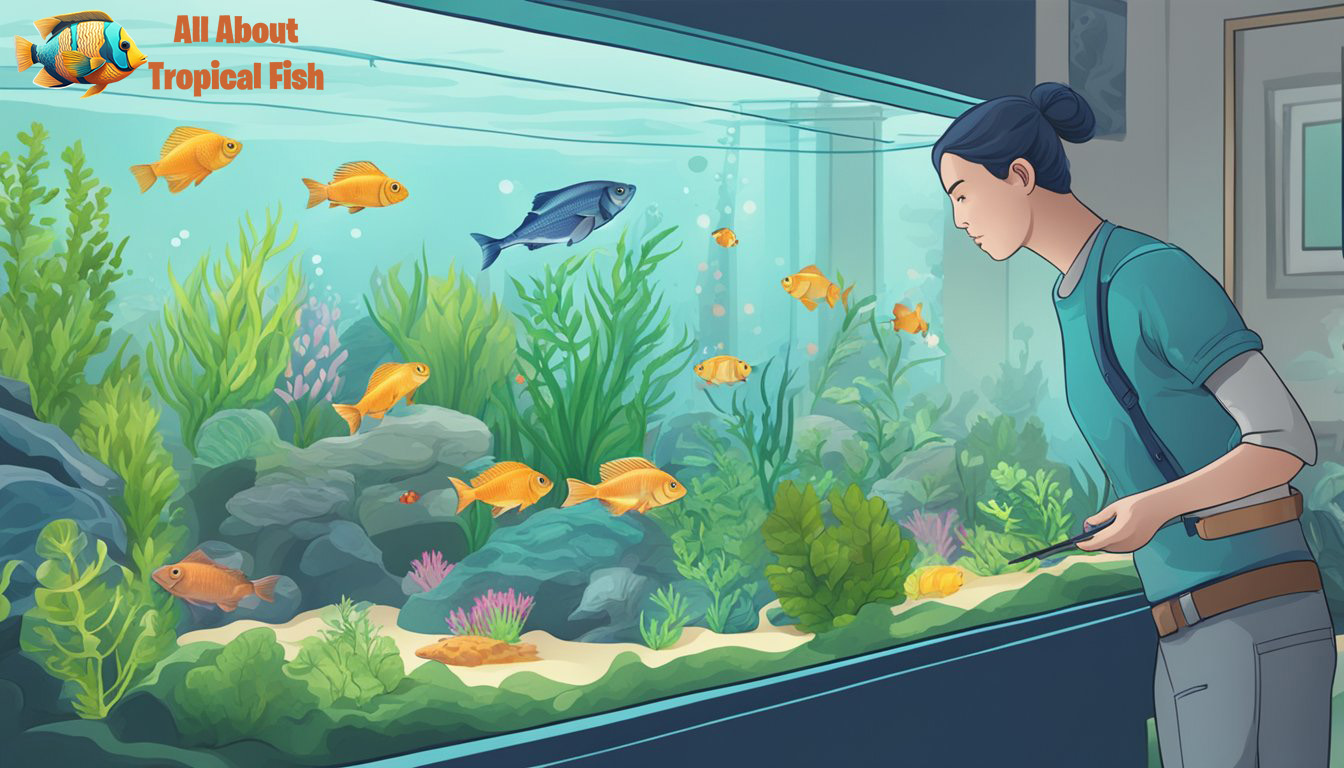
When setting up your aquarium, the harmony between fish species and the incorporation of aquatic plants plays a crucial role. Selecting compatible fish ensures a stable environment, and aquatic plants can enhance both the aesthetics and health of your tank.
Selecting Compatible Fish Species
- Tetras: These small, active fish prefer to be in schools. They are peaceful and can coexist with other non-aggressive species like guppies and neon tetras.
- Betta Fish: Known for their vibrant colors and flowing fins, bettas are territorial and should not be kept with other bettas. They require a peaceful environment and can be placed with fish such as tetras but not with fin-nipping species.
- Goldfish: These are cold-water fish and should not be paired with tropical species. They produce a lot of waste, so ensure your tank is large enough and your filtration is sufficient.
- Cichlids: A diverse group, cichlids have various temperaments. African cichlids, for instance, are best kept with other cichlids from the same region, while angelfish, a type of cichlid, can be kept with similar-sized peaceful fish.
- Guppies: Colorful and easy to keep, guppies are friendly and thrive in a community tank with similar-sized peaceful fish.
To maximize compatibility, consider:
- Water parameters (pH, temperature)
- Temperament (peaceful, semi-aggressive, aggressive)
- Size (small, medium, large)
Incorporating Aquatic Plants and Decor
- Tetras and Neon Tetras: They enjoy densely planted tanks, as it mimics their natural environment.
- Betta Fish: Prefer tanks with soft-leaved plants like anubias, which provide shelter without damaging their fins.
- Goldfish: May uproot delicate plants; opt for sturdy species like java ferns.
- Cichlids: Some dig and disrupt plants, so choose robust plants or use artificial decor. Rocks and caves work well for territorial fish.
- Guppies: Enjoy swimming through plant cover; fine-leaved plants like hornwort are great.
Consider light requirements and growth rates when adding aquatic plants. Use plants to create natural borders, hiding spots, and enhance your tank’s ecological balance. Remember, plant choices should support the needs of your fish while contributing to the overall health and aesthetic of your aquarium.
Considering Additional Factors
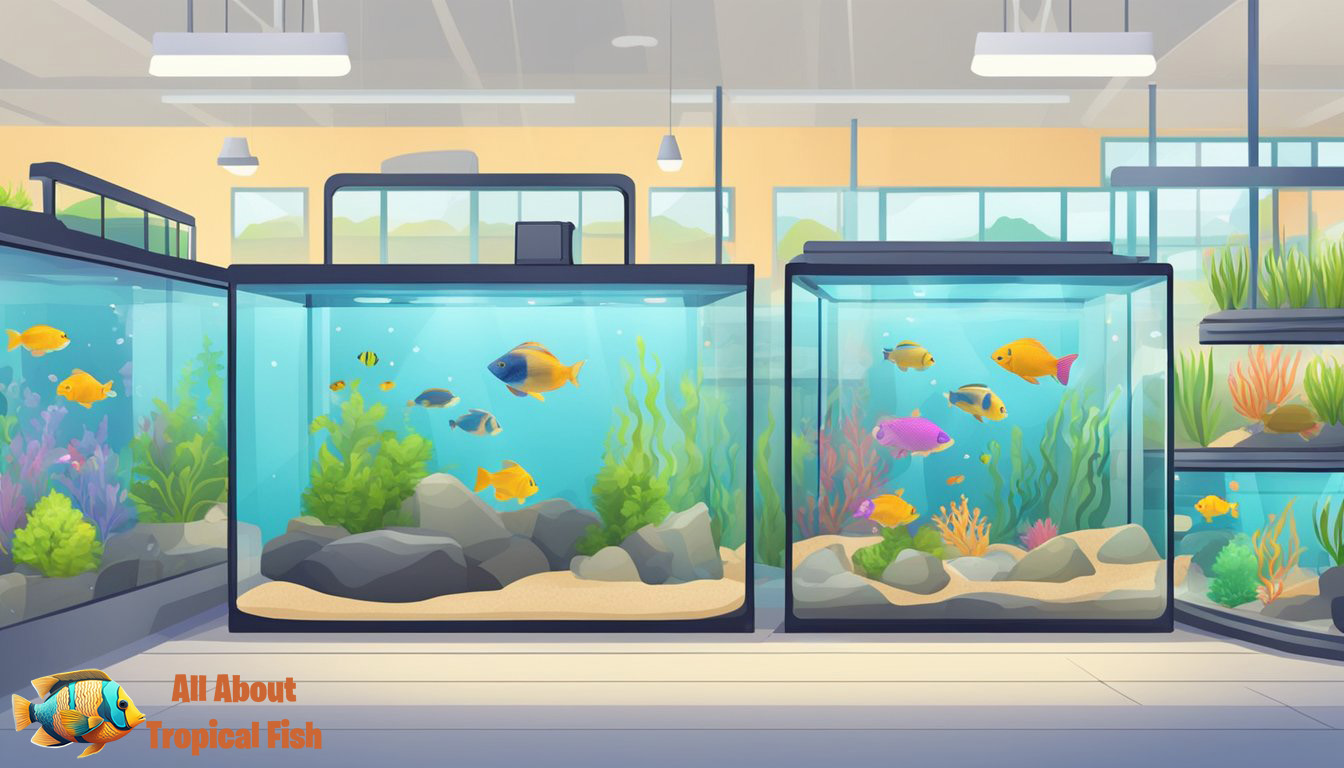
When choosing the perfect fish tank, beyond size and inhabitants, there are practicalities like weight considerations and lighting that you need to address. Let’s dive into these often-overlooked areas.
Accounting for Weight and Support
Weight is a crucial factor to consider. A gallon of water weighs approximately 8.34 pounds, and that’s before adding in the weight of gravel, decorations, and the tank itself. It’s essential to ensure that you have a stand or support system that can handle the full weight of your aquarium when filled. For instance:
- A 10-gallon tank can weigh over 100 pounds.
- A 50-gallon tank might tip the scales at over 600 pounds.
Thus, you should assess both the cost and space available for an appropriate aquarium stand that can support this amount of weight securely. Ignoring this could be disastrous.
Dealing With Lighting and Positioning Issues
Selecting the right location for your fish tank involves more than just aesthetic appeal. Be mindful of vibration and direct sunlight that can affect your tank’s environment.
- Vibrations from appliances or heavy traffic can stress your aquatic friends.
- Direct sunlight can lead to algae growth, temperature fluctuations, and affect the health of your fish.
Lighting is not just for visibility; it also supports plant growth and the overall health of your tank’s ecosystem. Therefore, consider these aspects:
- LED lighting often costs more upfront but saves on long-term costs due to energy efficiency.
- Ensure your lights are appropriate for the types of plants and fish in your tank.
Always keep in mind the space you have for your tank and whether it can accommodate extra equipment without disrupting your room’s flow. With these considerations, you’ll create a thriving environment for your aquatic pets.
Purchasing and Budgeting
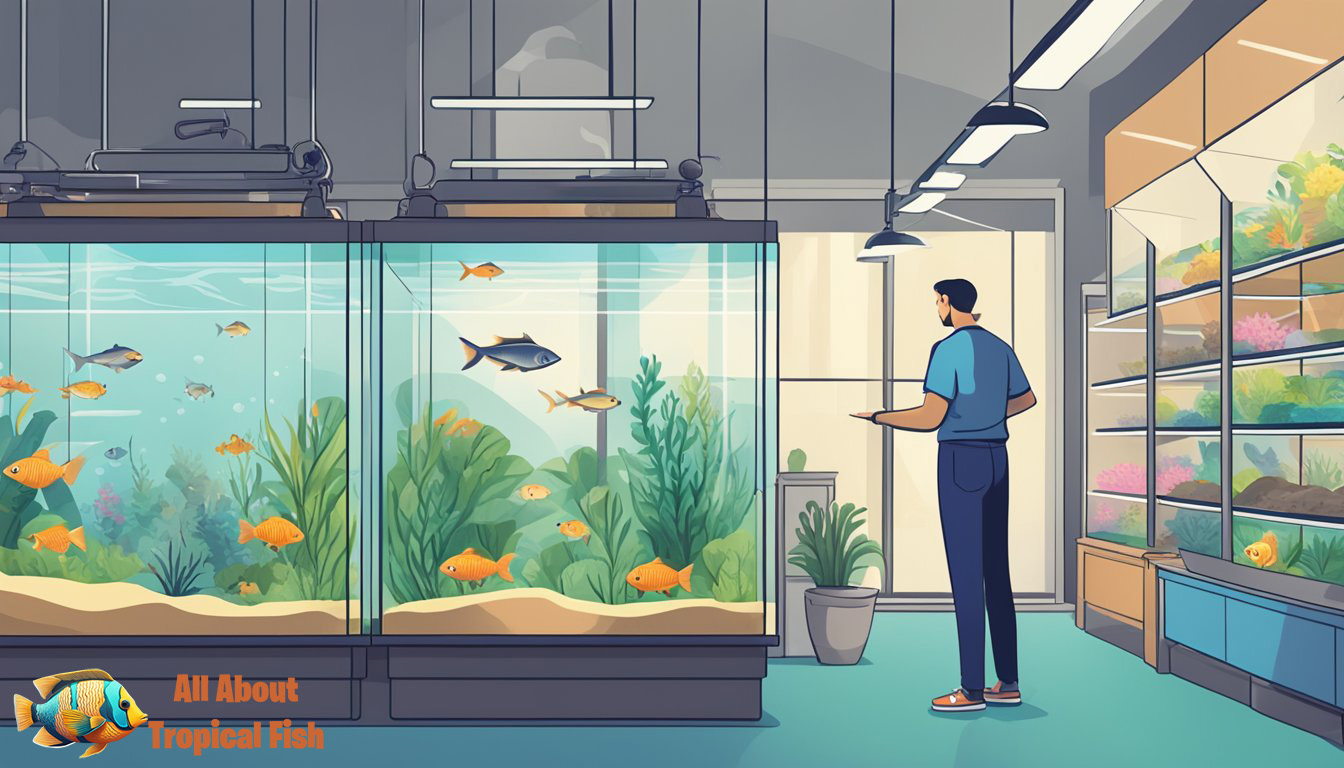
Understanding the costs involved and finding the best deals can help you stay within budget while meeting all your fishkeeping needs.
Estimating Overall Costs
To properly budget for your aquarium, you’ll need to consider several factors:
- Initial Purchase: The tank itself often represents just a fraction of the total expense.
- Equipment: Filters, heaters, lighting, and aeration systems are essential for maintaining a healthy environment.
- Decor and Substrate: Gravel, plants, and ornaments not only make the tank visually appealing but also provide hiding spaces that can reduce aggression among fish.
- Fish: Prices can vary widely depending on species and size.
Typical Costs might look like this:
| Item | Estimated Cost |
|---|---|
| Small Size Tank | $50 – $200 |
| Filtration System | $20 – $100 |
| Heater | $15 – $40 |
| Lighting | $20 – $150 |
| Substrate & Decor | $10 – $100 |
| Fish | $5 – $30 each |
Exploring Starter Kits and Deals
- Starter Kits: These often include the tank, filter, lights, and sometimes a heater. Kits can offer significant savings rather than buying each item separately.
- Deals: Keep an eye out for sales at local pet stores or online marketplaces. Bundling items can sometimes lead to discounts.
Make sure to read reviews and compare prices to ensure that any kit or deal includes quality equipment that suits the needs of the fish you intend to keep.
Advanced Aquarium Considerations
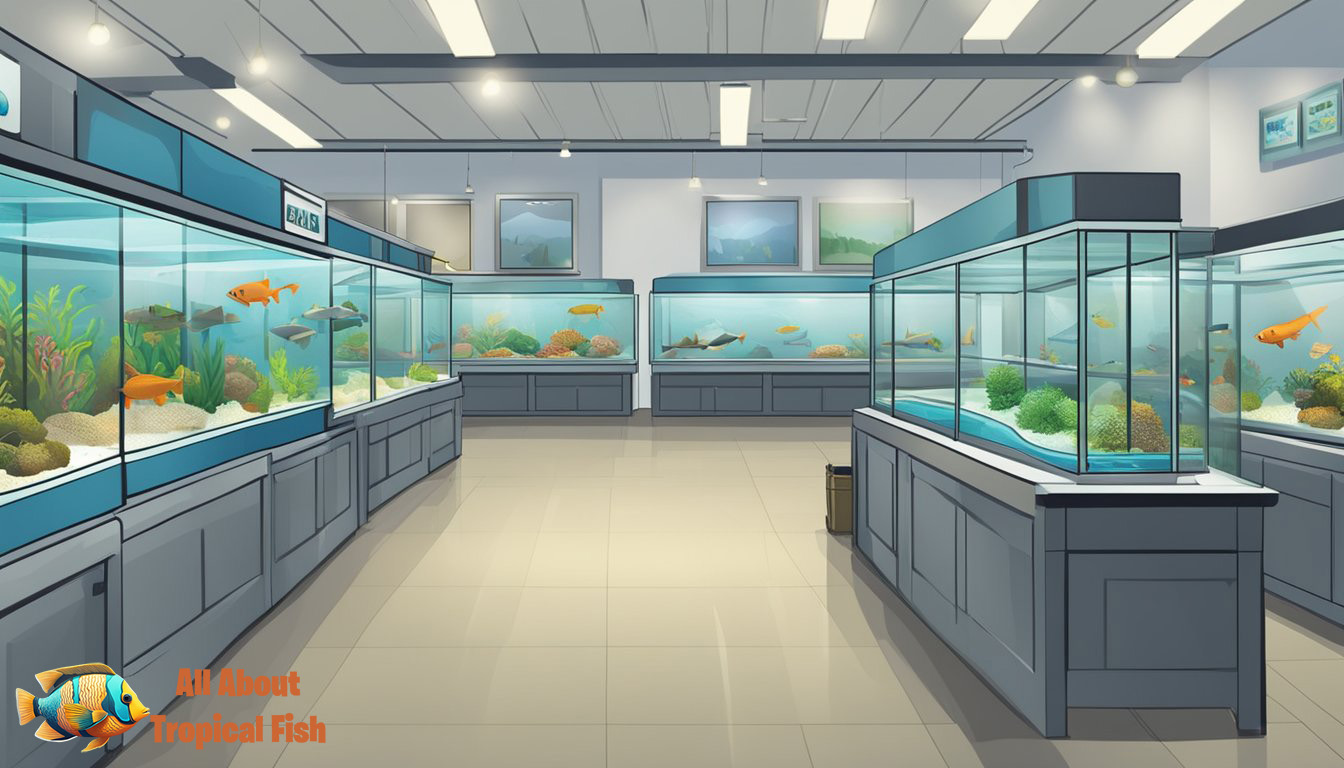
When you’re ready to elevate your aquarium beyond the basics, it’s important to consider the advanced equipment necessary for maintaining a healthy environment and the art of expert aquascaping for aesthetic appeal.
Delving into Advanced Equipment
For those with large aquariums, the right advanced equipment is crucial. You’ll want to ensure that the capacity of filtration systems can handle the volume of water efficiently. Look for canister filters or sumps, which provide robust filtration for larger tanks. It’s also wise to monitor water parameters with a high-quality test kit. For larger or more densely stocked tanks, consider a protein skimmer to remove waste compounds and improve water quality.
- Filtration: Canister filters, Wet/Dry filters, Sumps
- Testing: High-grade water test kits
- Additional equipment: Protein skimmers
Cultivating an Expert Aquascape
Aquascaping, the art of arranging aquatic plants, rocks, and wood in an aesthetically pleasing manner, requires a keen eye and understanding of how your aquascape will evolve. For live plants, proper lighting and CO2 systems are essential. Use layers of substrates, from nutrient-rich soils beneath to fine gravel on top, to provide plants with the necessary nutrients to thrive.
- Lighting: LED lighting systems with full spectrum for plant growth
- CO2: Injection systems calibrated for tank size
- Substrate: Layered with nutrients for plant roots
Avoiding Common Mistakes
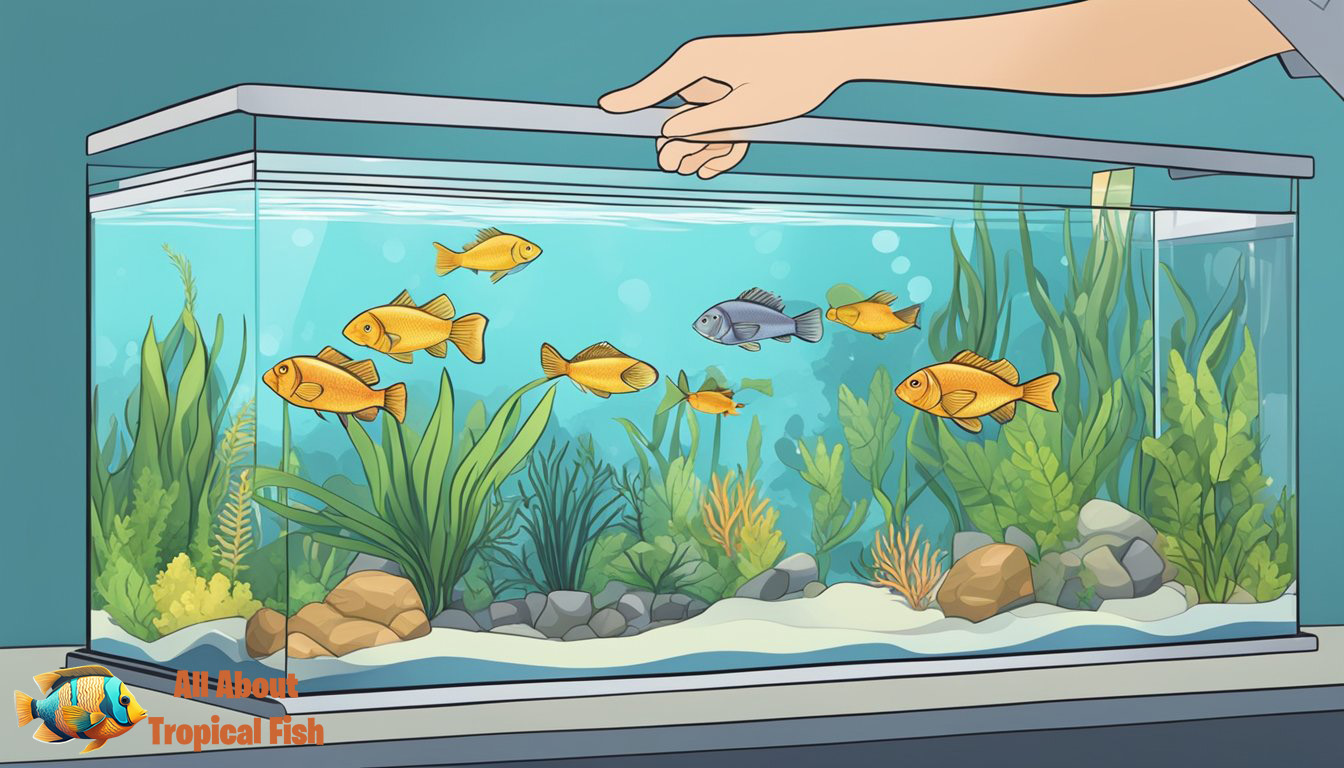
Setting up your aquarium properly from the get-go can save you a lot of trouble down the line. It’s important to consider the needs of your fish and the constraints of your space to prevent common issues.
Preventing Overcrowding
When selecting your fish tank, consider the adult size of your fish to prevent overcrowding. A good rule of thumb is to allow at least one gallon of water per inch of full-grown fish. This minimizes stress caused by limited space and reduces territorial conflicts. Remember that a fish bowl is not suitable for most fish due to its small size and poor water quality control. Here’s a summary:
- Tank Size Allocating Space:
- 1 inch of fish: 1 gallon of water
- Adult size: Account for fish’s full-grown size
- Avoid a Fish Bowl: Low capacity and unsuitable environment
Choosing the Right Tank Location
The weight of your aquarium increases significantly after it’s filled with water and adorned with substrate and decorations. Therefore, you should select a sturdy and level location that can support this weight and avoid the need for relocation. Tank material is also important; glass is a common choice, but make sure to consider low-iron glass options, which provide clearer visibility and less distortion. Metal tanks are rare but be wary of corrosion over time. Additionally, avoid places with direct sunlight to prevent algae growth and temperature fluctuations. If you have children or pets, high-traffic areas might lead to accidental scratches on the tank’s surface, so choose a location that minimizes this risk.
Upkeep and Long-Term Care
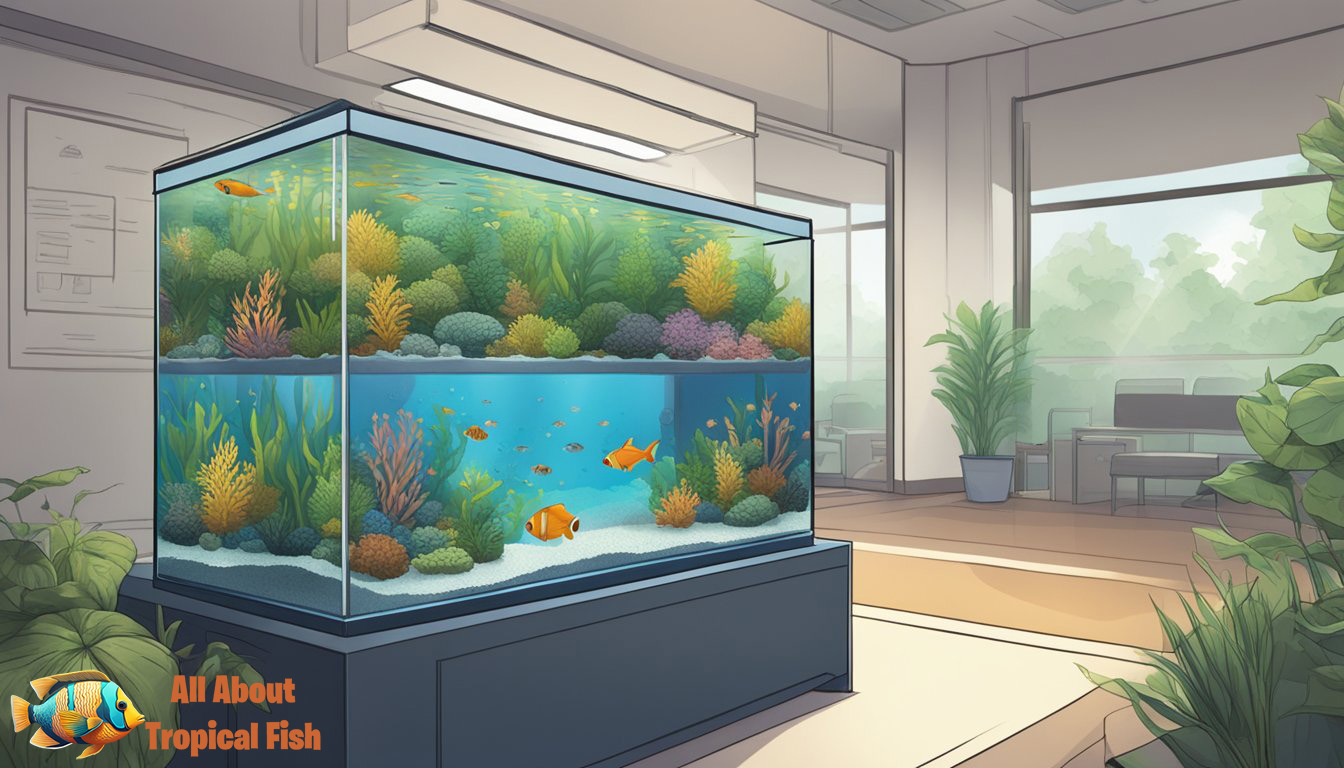
Choosing the right fish tank goes beyond the initial setup; it’s about committing to the upkeep and long-term care so your aquatic friends can thrive.
Fish Tank Longevity:
- A well-maintained tank can last many years. Regular care ensures that your investment pays off in the long term.
When to Upgrade:
- If your fish outgrow their home or you wish to introduce more companions, consider upgrading to a larger tank.
- Before upgrading, ensure you’re ready for the additional maintenance requirements a larger tank presents.
When the time comes to upgrade, do so with consideration to the increased care a larger ecosystem will require.
Conclusion
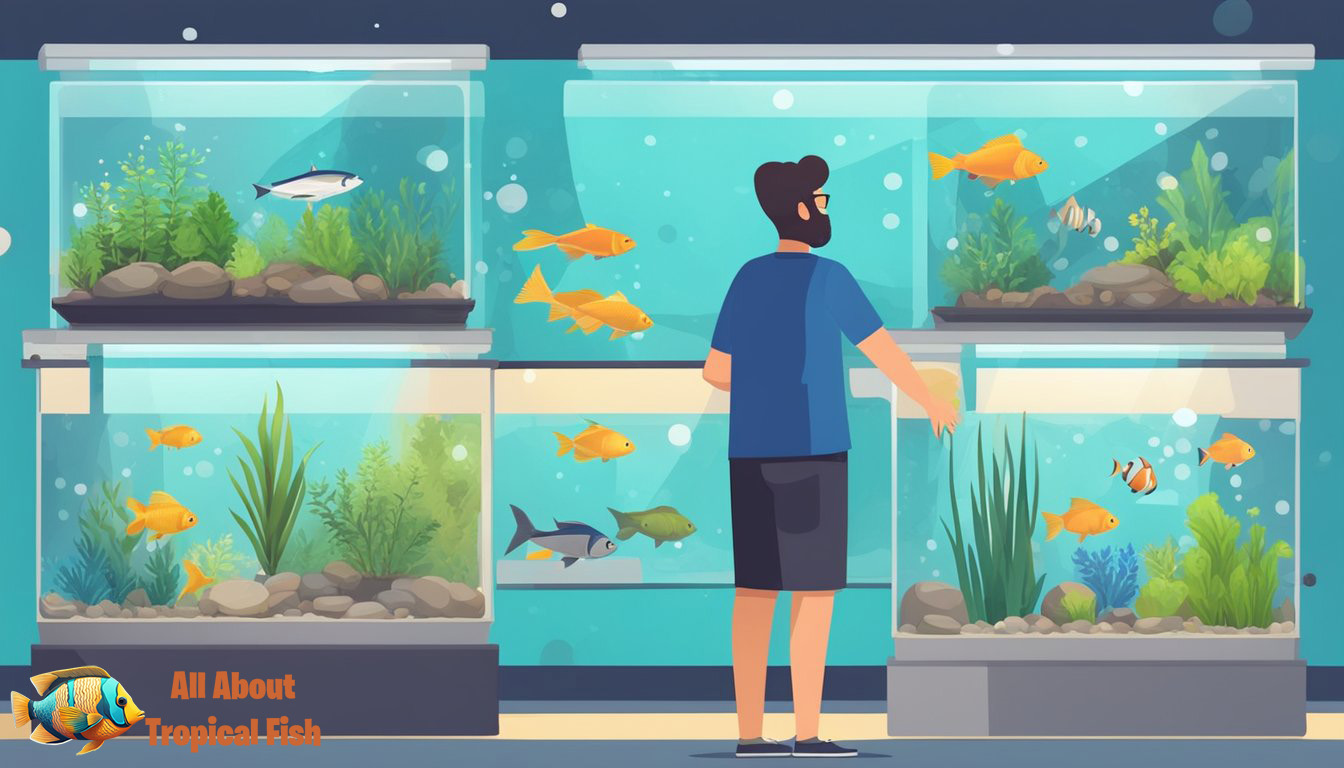
Selecting the right fish tank is important for the well-being of your aquatic friends and the aesthetic harmony of your space. Remember, a bigger tank often means a more stable environment for your fish. Here are a few key points to keep in mind as you make your decision:
- Space Matters: Ensure the tank is large enough for your fish to swim and grow. A cramped tank can lead to stress and health issues for your fish.
- Filtration and Aeration: A robust system is essential for maintaining a clean and oxygen-rich environment. This is key for the health of your tank’s inhabitants.
When considering the tank, factor in these aspects:
- Number and Size of Fish: Plan according to the species you intend to keep, accounting for their full-grown size and space requirements.
- Home Compatibility: Measure the intended area in your home to guarantee the tank fits well without causing disruption.
- Design Preferences: Choose a tank that complements your home’s décor. Tanks come in various shapes and materials—pick one that you’ll love to look at every day.
In short, balance functionality with aesthetics. With thoughtful consideration, you’ll find the perfect fish tank that ensures a healthy environment for your fish and a delightful addition to your home.



Leave a Reply